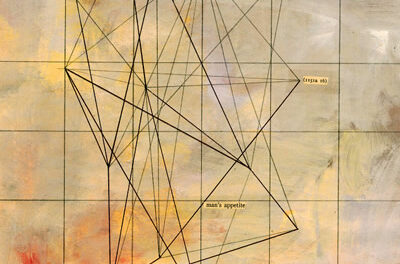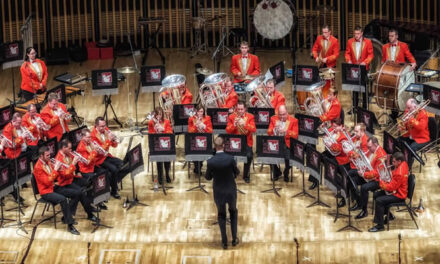The chamber musicians of Musica Judaica and the members of South of Delancey Klezmer Band poured their all into a collaborative adventure of music and art presented on the Sights and Sounds series by Raleigh Chamber Music Guild and the North Carolina Museum of Art in the museum’s auditorium on Sunday, March 16. Jewish art on display in the Museum’s permanent collection, Jewish classical music influenced by their traditional klezmer music, and folk music by a klezmer band distinctively revealed the creativity and improvisatory skills portraying the depth of feeling within the hearts and souls of Jewish artists. In addition, the concert date coincided with the Jewish holiday celebration of Purim, a remembrance of the narrow escape of the Jews from destruction in ancient Persia, as described in the Book of Esther.
Klezmer musical elements unified the electrifying selection of pieces, classical and traditional, in both halves of the program. The klezmer Yiddish scales of a minor character, Misheberakh and Freygish, unlike Western scales, contain three or four half steps that precipitate large leaps in other parts of the scale. The klezmer melodic style frequently pounces on those highly emotional augmented notes, which become major factors in creating such intense pathos. These scales not only have their roots in Eastern Europe but also in the music of the Middle East and North and South Indian classical music. (For much more information on these and other related scales or modes, click here.) In addition, klezmer music absorbed many complex rhythms from Eastern Europe, though frequently the rhythmic underlay is simply oom-pah, oom-pah. Thus, the afternoon became an unusual adventure into a musical culture delightfully different from our Western musical traditions.
The performance of Osvaldo Golijov‘s highly intricate and inventive Dreams and Prayers of Isaac the Blind (1994), the shining star of the classical klezmer portion of the afternoon, riveted the attention of the listeners with its plethora of changing sounds and fluid expressiveness. Fred Jacobowitz‘s brilliant klezmer clarinet playing, on A, B-flat, and bass clarinets, produced tones I would not have thought possible on the clarinet. He achieved guttural-sounding grace notes that were extraordinary. He executed fast cadenza passages with astonishing speed. He bent pitches and slid into notes with versatility. And with heart. He did it all.
Jacobowitz’s influential spark seemed contagious among the other members of the group: Dovid Friedlander and Jacqueline Saed Wolborsky, violins; Nate Leyland, cello; and Suzanne Rousso, viola. Their energy, ensemble, and fine musicianship gave much shape and excitement to a score that careened with abandon through frequent meter changes, quick bites of sound, double stops, harmonics, trills, and glissandi – almost anything that has ever been written for strings.
Movement one, which started intensely, increased its agitation with Friedlander’s fingers sailing high onto the G string – with great accuracy and verve. The movement almost ended in a frenzy, but because the agitation was spent, it broke into warm, tenuto chords, closing with harmonics.
Shortly after the opening of the second movement, Jacobowitz made this movement’s written-out cadenza sound natural, as if he were improvising. Later, Jacobowitz and Friedlander were drawn into what appeared to be improvisatory passages, separated by an octave or two sometimes; likewise Wolborsky and Rousso were paired and created much warmth in their passages. Both sets of players performed wonderfully together with an uncanny sense of their partners. Leyland tastefully provided the rhythmic glue that stabilized the ensemble and showed the warmth of his tone with brief solos in movements one and two.
The third movement portrays calm feelings with overtones of an ethereal nature.
A short, calm Prelude and Postlude frame the three movements of the Dreams and Prayer of Isaac the Blind. Golijov, an Argentinean Jew, based his deeply mystical work on a manuscript dictated by Isaac the Blind, a 12th-century rabbi in Provence, southern France. Golijov likens the Prelude and first movement to the sounds of the ancient Aramaic language, the second to Yiddish, and the third movement and Postlude to the sacred language of Hebrew.
Prokofiev’s Overture on Hebrew Themes, Op. 34 (1919), is scored for the same instruments as the Golijov piece with the addition of piano, played by Frank Pittman. This program opener caught my ear with its catchy klezmer theme; however, the compositional writing lacked imagination, and Prokofiev’s instrumental scoring covers the lower range of the dominant clarinet. Pittman’s piano work showed sensitivity to the balance issues in his careful handling of the instrument.
Music from the South of Delancey Klezmer Band* completed the afternoon’s concert. It was formed around 1996 by violinist Bert Chessin, who maintained his leadership until moving out of the area, perhaps around 2006. Delancey, Chessin explained, is a street in Manhattan on which many Jewish families lived. North Carolina then is south of Delancey, which led to the band’s name. Fred Jacobowitz currently directs the group. Klezmer bands typically play for important social events in the lives of Jewish families. Through the years, a number of performers have been in and out of the band, but two longtime members performed Sunday: Suzie Bolotin, vocals/piano; and Wilma Wallmark, trombone. Lindsay Schinasi, violin, a newer member of the group, also performed. The Klezmer songs, played with vigor from memory and by ear, included a Russian quadrille, “At the Rabbi’s Feast,” “Let’s Make Up,” and two others. Close communication from the leader to the members guided the unfolding song structure. This is a sharp, lively ensemble with a gift for entertaining. Jacobowitz demonstrated his flair for improvisation and has the technique for it that pops your eyes open. Bolotin exudes a charming presence as she accompanies or plays and sings. Wallmark particularly has fun with the slide part of her slide trombone. Schinasi doubled the clarinet melodic lines, no mean feat for coordination of rhythm and pitch.
To have a concert in the Museum that focuses on a part of the Museum’s collection contributes in an immeasurable way to the richness of the concert experience. Docent Elizabeth Kahn ably led an informative tour through the Museum’s Judaica collection, only one of two galleries in America to invest in such a collection. On the way, Kahn took the group to a painting, “Feast of Esther” (c.1625) by Dutch painter Jan Lievens (1607-74), which portrays the meaning of the celebration of Purim. The Judaica collection contains beautiful silver torah cases, torah pointers, sabbath candlesticks, ornate spice boxes marking the end of sabbath, and more. Coordinating selected art in the Museum so closely with related music made this Sunday afternoon a very impressionable one. Fred Jacobowitz and his musician friends picked an especially powerful combination.
Michel Borzykowski’s website includes lots more about the genre. And for more information about Jewish music in general, see the Jewish Music WebCenter.
*The band doesn’t seem to have its own website, but there’s a short (albeit out-of-date) description of it and its members in a huge listing of klezmer groups, here. The band is available for booking in many types of social settings. See Jacobowitz’s site (above) for details.












